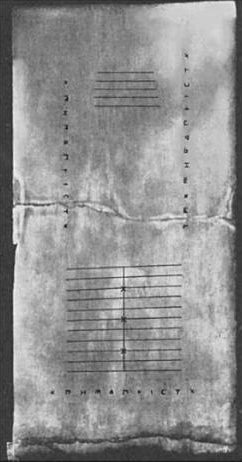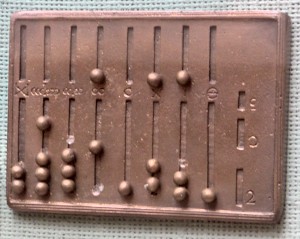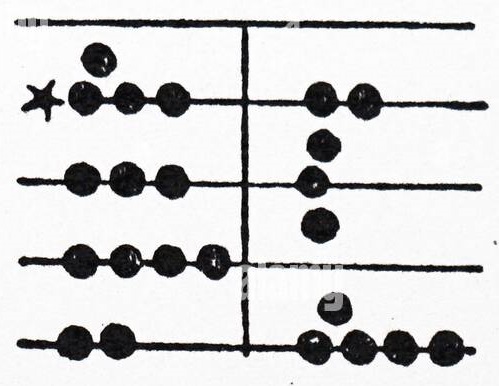Arithmetic by Counters
Ælfred se leof
This workshop demonstrates basic computations using a counting board, or abacus. The workshop is based on research I originally published in Cockatrice in 2002, which was itself based on scholarly work published by J M Pullan (1969) and Parry Moon (1971).
The basic idea behind all the abacuses mentioned in this article is that each horizontal row represents a power of ten. Counters placed in the lowest row represent the number of “ones”, counters in the second row represent the number of “tens”, and so on for as many digits as the calculator needs. This is the same idea as the “Arabic” notation that most people use today, except that we write a symbol for each digit instead of placing counters on a board.
A Brief History
Abacuses of various sorts have been used since ancient times. The earliest extant example is a marble tablet found on the island of Salamis in Greece, dated to about 300 BCE, and now at the Epigraphical Museum in Athens (Figure 1). The tablet has a series of lines on which to place counters, with crosses marking the “hundreds”, “hundreds of thousands”, and so on, in the same way that we insert commas at the “thousands” places to make large numbers easier to read. The dividing line in the middle can be used to separate the two numbers involved in a calculation.

Another famous counting board is the one attributed to Gerbert d’Aurillac, who taught in Reims in the tenth century, and later became Pope Sylvester II (Figure 2). Unlike most other abacists, Gerbert used purpose-made counters marked by Arabic numerals to represent the digit in each column, so that his numbers would have looked much the same as we write them out today, except that the shapes of the numerals have changed somewhat since then. Marek Otisk (2015) gives many examples of abacuses following Gerbert’s design from the tenth to twelfth centuries.
Romans (at least) also used sliding “hand abacuses” in which each row has a fixed set of beads that can be slid up or down to represent the number (Figure 3). This workshop will use the counting board, however, because it’s easier to make.

Calculation
The modern word “calculate” derives from the Latin word calculi, meaning “smoothed pebbles”. Later abacists also used purpose-made metal or horn counters known as jettons.
Period descriptions of how to use counting boards come to us from Johann Widman's Algorithmus Linealis (1488) and Robert Recorde’s The Grounde of Arts (1543). The algorithms demonstrated in this workshop follow Recorde’s book, as interpreted by Cheryl Periton (2015). The algorithms are better shown by a physical demonstration [Vimeo] than by writing them out in words, so these notes describe only the basic idea.
Addition is very simple. Put the two numbers either side of a line (Figure 4; the counters between the rows represent 5’s). Starting with the “ones” and working up, bring the counters in each column together. If you end up with ten more or counters in a single column, replace ten of them with a single counter in the row above it.

Subtraction is the inverse of addition. Instead of adding the counters in each row together, remove counters from the first number according to the counters in the same row in the second number. If the first number doesn’t have enough counters in a row, “borrow” a counter from the row above, which becomes ten counters in the current row.
Multiplication works by the same “shift-and-add” algorithm that works with Arabic notation (Figure 5). The basic idea is to multiply each digit of the first number (the multiplicand) by each digit of the second number (the multiplier), then add all the results together. Having memorised multiplication tables makes this faster, but it can also be done by adding each digit to itself the required number of times.
Division is the hardest calculation to perform and several methods were used in period. Recorde’s method works by shifting, multiplying and subtracting, similar to how I learned to perform “long division” in primary school. Move the divisor to the left until it’s as large as possible without exceeding the number to be divided. Work out how many times the shifted divisor can be multiplied without exceeding the number to be divided. Again, it’s helpful to know multiplication tables, but repeated subtraction also works. This gives the first digit of the quotient, which I’ll call q1. Now subtract q1 times the divisor from the original number; call the result the remainder. Repeat the process to get the second digit of the quotient q2, and reduce the remainder by q2 times the divisor. Continue until the remainder has been reduced to something smaller than the divisor.
References
Kubitschek, Wilhelm. XII. Die Salaminische Rechentafel, in Numismatische Zeitschrift, 1899.
Moon, Parry. The Abacus: Its History, Its Design, Its Possibilities in the Modern World, Gordon and Breach Science Publishers, New York, 1971.
Otisk, M. Descriptions and Images of the Early Medieval Latin Abacus, Średniowiecze Polskie i Powszechne, Vol. 11., 2015.
Periton, C. The medieval counting table revisited: a brief introduction and description of its use during the early modern period. BSHM Bulletin: Journal of the British Society for the History of Mathematics, Vol. 30, No. 1, 2015.
Pullan, J M. The History of the Abacus, F. A. Praeger, New York, 1968.
se leof, Ælfred. Arithmetic by counters. Cockatrice 16, November 2002.
